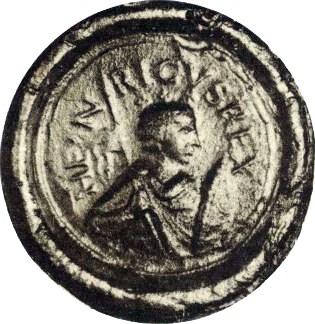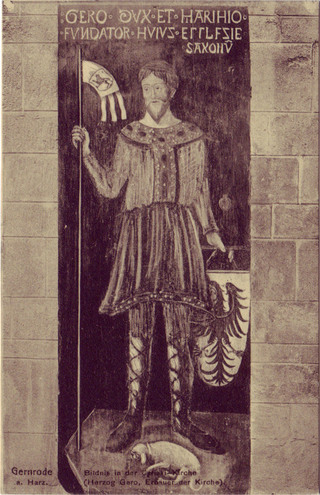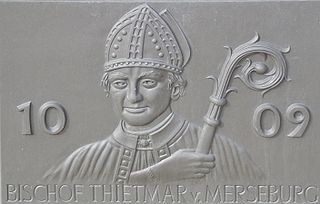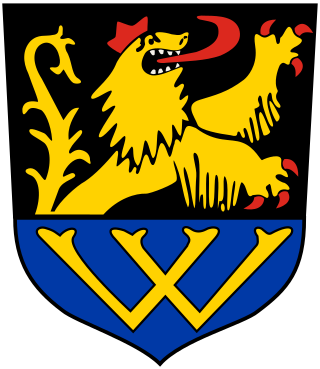
Henry the Fowler was the duke of Saxony from 912 and the king of East Francia from 919 until his death in 936. As the first non-Frankish king of East Francia, he established the Ottonian dynasty of kings and emperors, and he is generally considered to be the founder of the medieval German state, known until then as East Francia. An avid hunter, he obtained the epithet "the Fowler" because he was allegedly fixing his birding nets when messengers arrived to inform him that he was to be king.

The Northern March or North March was created out of the division of the vast Marca Geronis in 965. It initially comprised the northern third of the Marca and was part of the territorial organisation of areas conquered from the Wends. A Lutician rebellion in 983 reversed German control over the region until the establishment of the March of Brandenburg by Albert the Bear in the 12th century.

Polabian Slavs, also known as Elbe Slavs and more broadly as Wends, is a collective term applied to a number of Lechitic tribes who lived scattered along the Elbe river in what is today eastern Germany. The approximate territory stretched from the Baltic Sea in the north, the Saale and the Limes Saxoniae in the west, the Ore Mountains and the Western Sudetes in the south, and medieval Poland in the east.

Gero I, sometimes called the Great, was a German nobleman who ruled an initially modest march centred on Merseburg in the south of the present German state of Saxony-Anhalt, which he expanded into a vast territory named after him: the marca Geronis. During the mid-10th century, he was the leader of the Saxon Ostsiedlung.

Thietmar, Prince-Bishop of Merseburg from 1009 until his death in 1018, was an important chronicler recording the reigns of German kings and Holy Roman Emperors of the Ottonian (Saxon) dynasty. Two of Thietmar's great-grandfathers, both referred to as Liuthar, were the Saxon nobles Lothar II, Count of Stade, and Lothar I, Count of Walbeck. They were both killed fighting the Slavs at the Battle of Lenzen.
Dietrichof Haldensleben was a count in the Schwabengau, later also in the Nordthüringgau and the Derlingau, who was the first Margrave of the Northern March from 965 until the Great Slav Rising of 983. He also bore the title of a dux (duke) in contemporary sources. He was an ancestor of John V.

The Billung March or March of the Billungs was a frontier region of the far northeastern Duchy of Saxony in the 10th century. It was named after the family which held it, the House of Billung.
Thietmar (I) (also Thiatmar, Dietmar, or Thiommar) (died 1 June 932), Count and Margrave, was the military tutor (vir disciplinae militaris peritissmus) of Henry the Fowler while he was the heir and then duke of the Duchy of Saxony. He probably kept a small body of elite retainers (though he once feigned at having thirty legions behind him) armed with the latest in military technology and well-supplied with expensive horses. His armored cavalry played a decisive role in winning the Battle of Lenzen on 4 September 929, securing German domination along the Elbe river against West Slavic peoples.

The Battle on the Raxa river was fought on 16 October 955 over control of the Billung march between the forces of Otto I of Germany allied with the Rani tribe on one side, and the Obotrite federation under Nako and his brother Stoigniew with their allied and tributary Slav neighbours on the other. The Raxa river is identified with either the Recknitz or the Elde river. The German victory over the Slavs followed up on the August victory at the Lechfeld over the Magyars and marked the high point of Otto's reign.

The Glomacze or Daleminzi, were a West Slavic tribe of Polabian Slavs inhabiting areas in the middle Elbe (Łaba) valley. According to early 11th century chronicler Thietmar of Merseburg, they were called as Daleminzi by the Germans, and as Glomacze by the Slavs.

The Lutici or Liutizi(known by various spelling variants) were a federation of West Slavic Polabian tribes, who between the 10th and 12th centuries lived in what is now northeastern Germany. Four tribes made up the core of the federation: the Redarians, Circipanians (Circipani), Kessinians and Tollensians (Tholenzi). At least in part, the Lutici were a continuation of the Veleti. In contrast to the former and the neighboring peoples, the Lutici were not led by a Christian monarch or duke, rather power was asserted through consensus formed in central assemblies of the social elites, and the Lutici worshipped nature and several deities. The political and religious center was Radgosc.
Stoigniew was an Obotrite leader, who reigned during the middle of the tenth century. He is mentioned as a member of the princely Nakonid dynasty in the medieval chronicles of Thietmar of Merseburg and Widukind of Corvey.

The Counts of Stade were members of the Saxony nobility beginning in the 10th century. Stade had developed since the 8th century as a principal center of trade and communications. The Counts of Stade created their domain between the lower Elbe and Weser rivers. They extended their power northwards with the acquisition of Dithmarschen in the 11th century. They became the Margraves of the Nordmark in 1056. There is also a close political and familial relationship between the Counts of Stade and the Counts of Walbeck. The Northern March was replaced with the March of Brandenburg by Albert the Bear in the 12th century. The family of Counts of Stade is referred to as the House of Udonids.
Lothar II (874-929), Count of Stade, son of Lothar I, Count of Stade, and Oda of Saxony, daughter of Liudolf, Duke of Saxony. Lothar was the great-grandfather of Thietmar of Merseburg, and is frequently confused in genealogical sources with Thietmar’s other great-grandfather of the same name who was Count of Walbeck.
Henry I the Bald was the Count of Stade. He was the son of Lothar II, Count of Stade, and Swanhild of Saxony. Henry is recorded as a cousin of Otto I, Holy Roman Emperor, but their exact relationship remains a mystery. Henry was also appointed Count of Heilangau, the ancient capital of Stade, in 959.

The Counts of Walbeck ruled a medieval territory with its capital Walbeck northeast of Helmstedt in the present town Oebisfelde-Weferlingen in Saxony-Anhalt. The foundation of the Archbishopric of Magdeburg established the region as firmly in the oversight of Otto the Great, Holy Roman Emperor. The first Count of Walbeck, Lothar I, was great-grandfather of Thietmar, Prince-Bishop of Merseburg, chronicler of the Ottonian dynasty of Germany and the Holy Roman Empire. Two of Thietmar’s great-grandfathers, both named Lothar, were killed in the Battle of Lenzen, pitting the forces of Henry the Fowler against the Slavs. The early Margraves of the Nordmark were descended from the House of Walbeck.
Lothar I, Count of Walbeck, of unknown parentage. Lothar was the great-grandfather of Thietmar of Merseburg, and is frequently confused in genealogical sources with Thietmar's other great-grandfather of the same name who was Count of Stade.
Siegfried I, Count of Stade, son of Lothar II, Count of Stade, and Swanhild of Saxony, brother of Henry I the Bald, Count of Stade.
The Battle of Pritzlawa (Prinzlowa) in 1056 took place near present Quitzöbel between the Saxons and the Slavic Liutizen. The battle was a disaster for the Saxons, killing many knights and their leader William, Margrave of the Nordmark.
The siege of Gana was a twenty-day siege by a German army led by King Henry the Fowler against a Slavic Glomacze fortification, that took place in early 929 at the fort of Gana, named so after the nearby Jahna river.










